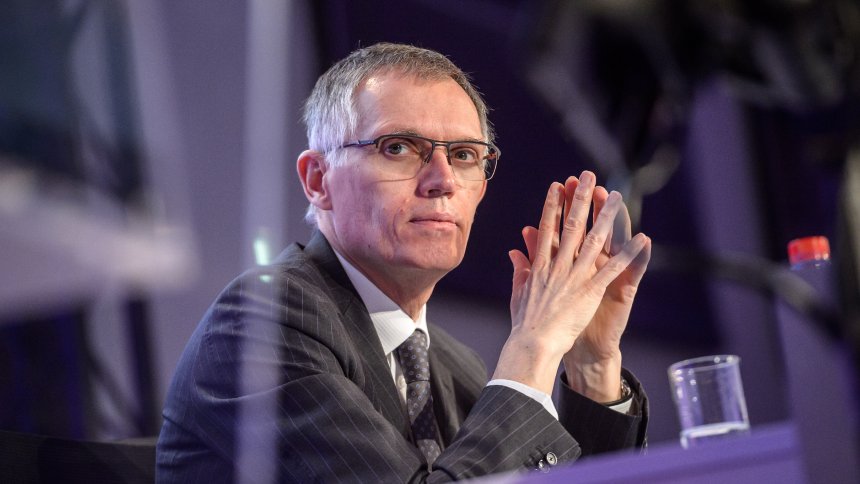After the Opel takeover, PSA will be Europe’s second-largest automaker. The group is a real threat to the market leader VW – especially in the future field of electromobility.
TESSON / EPA / REX / Shutterstock
Carlos Tavares
Monday, 06.03.2017
20:40
PSA boss Carlos Tavares prefers to lead his company with clear goals. The avid racer also loves the competition. He wanted to form a “real European champion” from PSA and Opel, said the native Portuguese on Monday. For the purchase of the traditional German brand PSA will pay 1.3 billion euros, in addition to another 900 million euros for the purchase of the financing business of GM Europe.
By the end of the year, the acquisition should also have the placet of competition authorities, Tavares hopes. If all goes well, the French automaker rises with its previous brands Peugeot, Citroën and DS to number two on the European market.
Worldwide, PSA and Opel / Vauxhall had come to around 4.1 million passenger cars and light commercial vehicles last year. This is still significantly less than market leader Volkswagen, which sold around 10 million vehicles last year with its twelve brands. The range from the budget brand Skoda to the absolute luxury class (Bentley, Bugatti) PSA will continue to offer little.
The new competitors should not underestimate the Wolfsburg. In some markets and segments PSA is strong – even with an important future topic. Where does VW have to make a real effort in the future, where is there a risk for the time being?
1. Southern Europe
With the purchase of Opel and Vauxhall, PSA increases its dependence on the European market. The models of the Rüsselsheimer are sold almost exclusively on their home continent, because General Motors kept the export of Opel models for years small. In the model range, there are many overlaps: Opel offers mainly smaller vehicles and compact models, at Peugeot and Citroën is similar.
These are particularly common in southern Europe, according to figures from the European Automobile Association ACEA: in Italy, the fourth largest new car market in the EU, 80 percent of all new cars sold were in the “small” and “lower medium” sectors last year. In Spain, the fifth largest market in the EU, it was 72 percent. In Germany, these two segments accounted for 61 percent of all vehicle sales.
Video: After 88 years at GM Opel is French
If PSA and Opel bundle their marketing forces in Southern Europe and quickly share their sales network, they could exploit cost advantages over the Wolfsburgers. In addition, PSA and Opel have been developing smaller vehicles since 2012: The new Opel SUV Crossland X, the Citroën C3 Picasso and the Peugeot 2008 are almost identical in their construction – and are all manufactured at the Opel Zaragoza plant.
2. Electromobility
The Wolfsburg want to play the lead in electric cars and to 2025 world market leader. At first glance, PSA threatens little danger: the French have not produced their own battery car. Tavares had announced for 2019 its own e-mobile with a competitive range.
Fails the Opel takeover, that could go faster. Opel has the Ampera-e, the sister model of the Chevrolet Bolt, a car on offer that comes under everyday conditions with a single charge well over 350 kilometers. Although GM has probably well secured his patents and technologies for the car. But the Opel project managers for the Ampera-e should have also received important insights into calculation and production. This could help the French to catch up faster with VW – especially since before 2020, no E-Volkswagen with a large battery on the road rolls.
3. Growth markets
For their thriving China business, the Wolfsburg must not fear too much of PSA. Although the French have recently raised new factories in China and introduced extra models for the Chinese market – also because of their Chinese anchor shareholder Dongfeng. But last year things did not go well for PSA: sales dropped from 736,000 (2015) to 618,000 vehicles, with market share falling to 2.7 percent – even though the overall Chinese market grew.
A quick export of Opel models to China is not realistic: First, it is likely that GM has excluded exactly in the sales contracts. On the other hand, Tavares announced at the end of February at its annual press conference that an export of Opel vehicles outside of Europe is “absolutely possible”. But only when Opel sees “light at the end of the tunnel”, that is profitable. That should hardly be the case before 2020, according to the march route announced today. Then to introduce a completely new brand in China, should be expensive.
Incidentally, the same applies to the United States. PSA has not been present there for decades and is now planning a kind of soft return with a ride service offering, ie a new mobility service. This should hardly be a viable basis for a larger vehicle export of several PSA brands.
However, PSA has a few potential growth markets in focus, where it could go much faster. Iran, for example, where the Group has already concluded joint ventures with local manufacturers for on-site production. The VW Group has nothing to offer there. Or India, where PSA has bought the traditional Indian brand Ambassador and now ventures with a joint venture a new start.
VW strives for years in India. But the price competition is tough, new cars are sometimes offered for less than 4000 euros. Since the Wolfsburg can not follow suit. On a real cheap car VW has failed so far.
PSA – unlike competitor Renault – can also be super cheap so far not so good. But that could work in conjunction with Chinese automaker and PSA shareholder Dongfeng. The acquisition of the brand Ambassador, for decades one of the cheapest models in India, speaks in any case.

